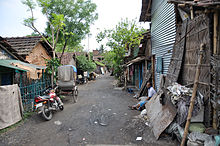Reading Design Like You Give a Damn was eye opening, yet at the same time, made me somewhat dubious about the role of an architect. The statement that, “Over time, the worlds of relief and development became divorced from the worlds of architecture and design” is, in my opinion, very worrisome. (Stohr 34) While architects do of course play a great role in housing, in many cases of disaster relief and development work, architects aren’t the first profession that comes to mind as a resolver of such issues. “Some employed architects but most depended on engineers to design and oversee the construction of projects.” (Stohr 40) These readings cover many global issues, however one detail that caught my attention was the repeated discussion of the role of the architect. Reading about these topics almost makes one wonder about the structure of our architectural education curriculum. In many cases, architecture students focus on the design of a single building, often taking into consideration the ‘site’, in what one could argue quite a superficial way. Hannes Meyer’s self definition of architecture sums it up quite well, “Architecture is a process of giving form and pattern to the social life of the community. Architecture is not an individual act performed by an artist-architect and charged with his emotions. Building is a collective action.” (Stohr 36)
And unlike the overall tone of Design Like You Give a Damn, architects are very much involved with the process of experimental housing. PRIVA-Lima, for example, is an international collaboration between architects in order to “test the concept of low-rise high-density housing.” (Garcia 27) The perfectly designed neighborhood. While PRIVA is a strong concept in many ways, I think one of the most important key factors is the way it’s designed with expansion in mind. This means that the family can expand their home based on their ever changing needs. PRIVA sees this issue with housing where there is no room for expansion and essentially results in a decrease in value of the site. However with this designed neighborhood, families would be able to adapt their homes based on their needs. This being said, the master plan is designed so that these expansions never causes over crowding as the layout resists a higher density. The article outlines that there are three main strategies; a pedestrian axis through the neighborhood, network of plazas and pedestrian passages, and traffic separation. (Garcia 28) While it’s usually easy to be negative about these kinds of ‘utopic’ ideas of neighborhoods and housing, I feel that this is actually a very strong design. For example, the design of this neighborhood also takes into consideration that each location is unique, and therefore offers a variety of opportunities that should not be limited by strict zoning plans on the part of the designers. The article talks about how these individual locations can create moments for entrepreneurship, which would increase the economy of the neighborhood. (Garcia 30) The fascinating thing about this is that while PRIVA ‘designs’ for these opportunities, they are instances that naturally develop in informal cities all across the world; as seen in Lagos, Mumbai, etc. So PRIVA is essentially, one could argue, a designed slum, without the ‘negative’ properties of a slum.
It’s almost as though the plan of the PRIVA could be copy and pasted all across the world, before slums actually develop, almost like a template for ‘slum’ development — which at that point would have to be called something else and not a ‘slum’. Of course, that would be in an ideal world, and we definitely don’t live in an ideal world. Foreseeing such needs is not always possible. As Slums and Urbanization describes it, the three elements in an urban complex are the railroad, the factory, and the slums. However, the reading talks about how “‘Free competition’ alone determined location, without thought of the possibility of functional planning.” (Mumford 17) There was no authority in the planning of the factory placements, accounting for noise and pollution from factories and making an effort to locate housing in different locations. In most cases, a lot of the issues came with the lack of consideration for the general public when designing the railroads (which were designed by engineers, not architects) where the “movement of trains was more important than the human objects”. (Mumford 19) It goes back to Hannes Meyer’s definition of architecture making a difference for the community. And while the education of the architect may seem to focused on the artist-architect charged with emotions, it is the architect who essentially tries to find a solution for housing that considers the residents. Because while aid workers consider these issues as planning and policy, architects see it as a design challenge. (Stohr 34)
Works Cited
Mumford, Lewis. The City in History: Its Origins, Its Transformations, and Its Prospects. New York: Harcourt, Brace & World, 1961. Print.
Garcia-Huidobro, Fernando, Diego T. Torriti, and Nicolas Tugas. “The Experimental Housing Project (PREVI) Lima.” Architecture Design (2011): 26-31. Print.
Stohr, Kate. Design like You Give a Damn: Architectural Responses to Humanitarian Crises. New York, NY: Metropolis, 2006. Print.


